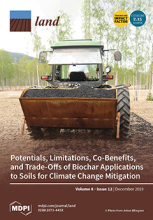Land Library
Welcome to the Land Portal Library. Explore our vast collection of open-access resources (over 74,000) including reports, journal articles, research papers, peer-reviewed publications, legal documents, videos and much more.
/ library resources
Showing items 1 through 9 of 12.The character of Amman, Jordan, as the "City of Waters"—referring to the abundance of water flowing in its known stream—has faded away because of the municipal policy to cover the stream in the 1960s which gradually changed the ecological character.
As global consumption and development rates continue to grow, there will be persistent stress placed on public goods, namely environmental amenities. Urban sprawl and development places pressure on forested areas, as they are often displaced or degraded in the name of economic development.
The Earth’s landscape has a complex evolution and is the result of the interactions involving surficial processes, climate, tectonic, and human activity [...]
Across the United States, there has been a growing interest in local food production, which provides an alternative way to increase self-sufficiency and support greater well-being and food security at the community level.
With the notion of landscape urbanism long neglected, interlinkages between ecology and architecture in the built environment are becoming visible. Yet, the diversity in understandings of the interconnections between cities and nature is the starting point for our research interest.
The current paper examines the legitimacy dilemmas that rise from local governments’ direct policy instruments and market interventions. It takes the case of public land management strategies.
Interest in green infrastructure (GI) has grown in research, policy and planning in recent decades.
In recent years, a new era of interventionism has emerged targeting the development of African cities, manifested in ‘fantasy’ urban plans, surging infrastructure investments and global policy agendas.
This paper examines two periods of renewal in Washington, DC, USA’s southwest quadrant and their relationship with displacement. The paper situates this discussion within both the local historical continuum and globally-recognized paradigms, such as “the right to the city”.







